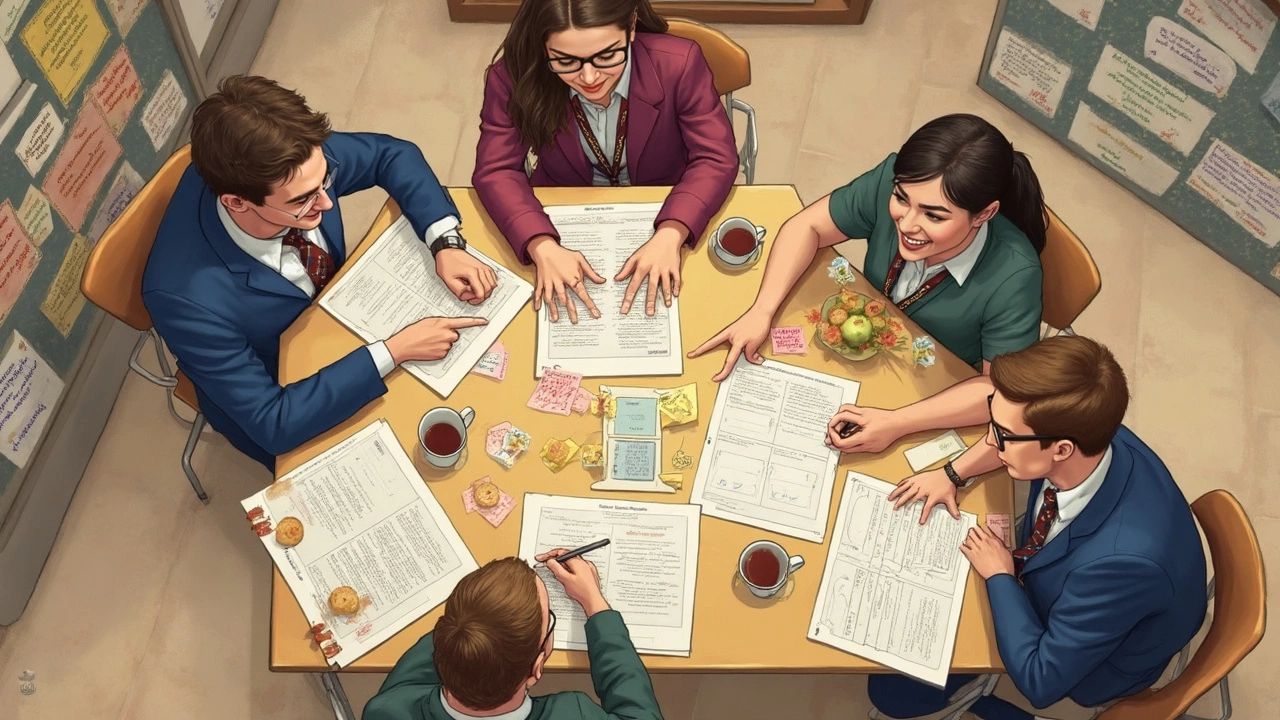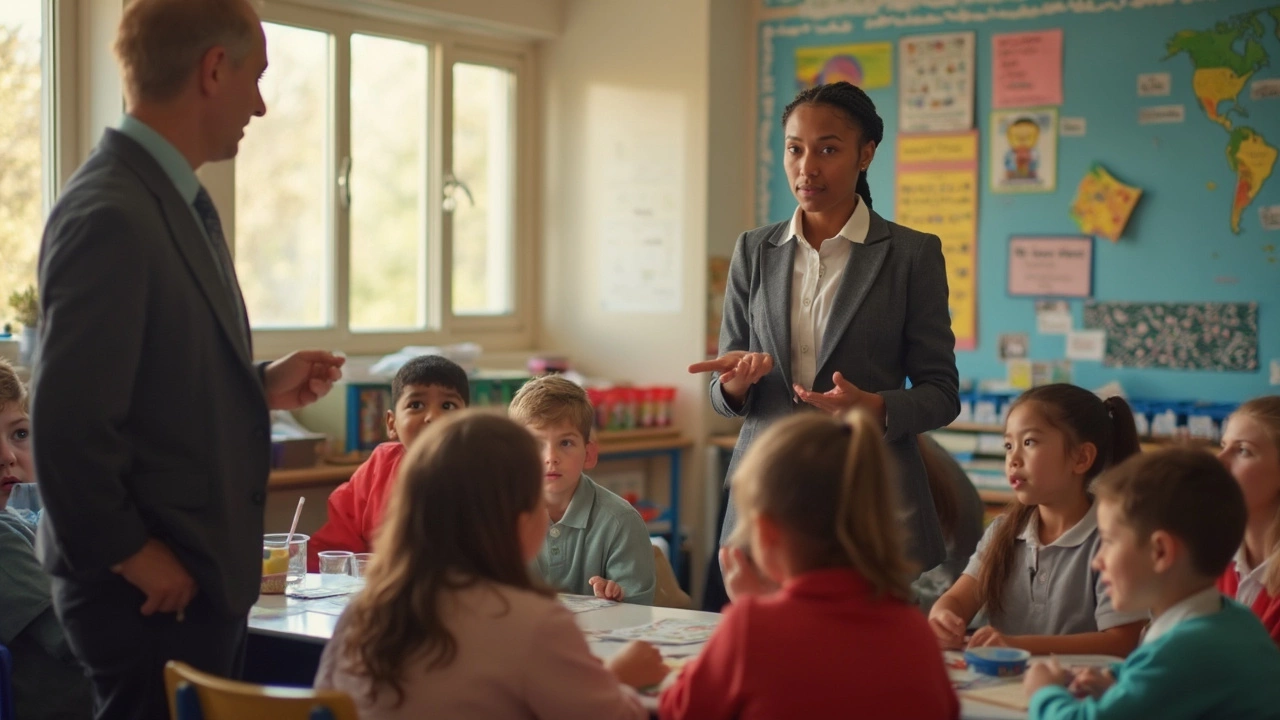You don’t really learn to teach by just reading about it. Student teacher training is that bridge between college classes and having your own classroom—think of it as a test drive before you get the keys. During this time, you step into an actual school, help lead lessons, and basically learn how teaching feels in real life.
This isn’t just about standing at the front and talking. You’ll make lesson plans, grade real assignments, and deal with the kind of surprises textbooks never mention—like what to do when a fire drill interrupts your math test or when a lesson totally flops. You’ll work closely with an experienced teacher who will give you honest feedback (sometimes uncomfortably honest), and you’ll see what teaching is like on both the good days and the tough ones.
If you’re wondering whether student teaching is a make-or-break step, here’s the truth: almost every teacher will tell you those months changed them more than anything they learned sitting in class. You’ll find out fast what works with students and what crashes and burns. The more open you are to trying, failing, and asking questions, the more you’ll actually get out of it—and the more confident you’ll feel when you finally have a class of your own.
- What Student Teacher Training Really Is
- How the Training Process Works
- Biggest Learning Moments (and Common Mistakes)
- Tips for Thriving During Student Teaching
- Why This Experience Matters for Your Career
What Student Teacher Training Really Is
Student teacher training is the real-world practice for becoming a full-time teacher. Instead of just reading about lesson plans, classroom management, or child psychology, you actually get in the classroom and do the work. This hands-on period—sometimes called a teaching internship or practicum—pairs you up with a certified teacher (your mentor) who shows you the ropes, then lets you try out the job for yourself.
You’re not a full employee, but you’re way past being just an observer. You play an active role in teaching, planning, and interacting with students. Most programs require you to do this full-time for 12 to 16 weeks. In some countries and states, you need to get a certain number of hours (often at least 450) to meet certification requirements.
| Average Student Teacher Training Duration | Minimum Required Hours | Role of Mentor Teacher |
|---|---|---|
| 12-16 weeks | 450-600 hours | Observes, coaches, and gives feedback |
This period is where you learn not just what to teach, but how to teach it so kids actually get it. For example, you’ll figure out how to tweak lessons if half the class is confused, how to handle tricky parent calls, and what to do if classroom tech fails.
If you hear people talk about student teacher training as a 'safe zone,' there’s some truth there. You can make mistakes, get real feedback, and improve—all with a support network around you. But don’t expect it to be easy. You might have to juggle lesson planning with college assignments or deal with kids who put your patience to the test.
- Expect to follow your mentor’s schedule—early mornings, lunchroom duty, everything.
- You’ll need to track your progress, reflect on what works and what doesn’t, and meet with your supervisor regularly.
- Most places require you to work with students from different backgrounds, so you’ll see firsthand how kids learn in all kinds of settings.
If you want to become a teacher anywhere in the U.S. or most other countries, student teacher training is required. It isn’t just a box to tick for your diploma; it’s where you actually become a teacher.
How the Training Process Works
If you’re curious about what actually happens during student teacher training, it’s more structured (and sometimes more intense) than people think. It usually kicks off after you’ve taken your core education classes, right when you’re itching to get away from endless theory and actually try teaching. Most U.S. student teachers start their placements in the final year of their programs, with the whole thing lasting from eight weeks up to a full school year depending on your college and state requirements.
You’re not just thrown into a classroom solo—thank goodness. Here’s the step-by-step rundown most programs use:
- Observation: For the first week or two, you shadow your mentor teacher, watching how they run lessons, manage the class, and connect with students.
- Assisted Teaching: Now you start helping out, maybe leading a small group or handling a warm-up activity. You see the little things, like how to get students' attention or keep track of attendance, up close.
- Solo Teaching (Gradual Release): As you grow more confident, your mentor hands over more of the class time to you. Eventually, you’re planning whole lessons and running the class, while your mentor observes and gives feedback.
- Reflection and Feedback: Regular check-ins with your mentor and university advisor help you figure out what’s going well (and what needs work). Expect weekly meetings and lots of honest talk.
- Assessment and Grading: You’re graded on everything from lesson plans to classroom management to how you handle parent communication. Yes, there’s paperwork—but it’s all stuff you’ll need to know for your own classroom later.
To put things in perspective, here’s how typical student teaching placements look in terms of time:
| State | Typical Placement Length | Full Load Teaching Required? |
|---|---|---|
| California | 16-20 weeks | Yes |
| New York | 14-16 weeks | Yes |
| Texas | 12 weeks | Usually |
| Florida | 10-12 weeks | Often |
Different schools do things their own way, but you’ll always get a mix of observing, co-teaching, solo teaching, and feedback sessions. Being proactive helps: ask questions, try different strategies, and treat this like real practice—not just a box to check off. What you put into your training is a pretty good preview of how you’ll handle your first year for real.

Biggest Learning Moments (and Common Mistakes)
You can’t talk about student teacher training without mentioning the real-life curveballs it throws at you. Almost no one walks into their placement and glides through without a few mess-ups. That’s just part of the deal—and where most growth happens.
For starters, classroom management trips up a lot of new teachers. It’s one thing to plan a perfect lesson; it’s another to keep twenty kids focused after recess. Studies from the National Center for Education Statistics show that nearly 60% of new teachers say controlling the class is the biggest challenge in their first year. You’re going to try things that flop, like letting the kids "self-regulate" group work (which usually means chaos at first). The trick is being honest with yourself, and using your mentor’s advice right away instead of just guessing.
Another eye-opener is learning just how fast the day goes—and how often you run out of time mid-lesson. Student teachers almost always underestimate how long instructions or activities take, so you end up rushing, or worse, not finishing what you planned. You get better at this quickly, but here are some tips:
- Break lessons into shorter chunks—think 10 to 15 minutes.
- Practice transitions, like moving from whole-class to small group work, so you don’t lose momentum.
- Have a couple of five-minute “backup” activities ready for when the lesson wraps up ahead of time.
Feedback can sting, especially when your mentor is blunt about what didn’t go well. But research from teacher prep programs in the US shows student teachers who ask for and use feedback make bigger gains in classroom performance. Don’t get defensive. Treat it like a GPS for your teaching—sometimes you need to reroute fast.
Here’s a quick look at where most student teachers hit bumps, and the biggest “aha!” moments:
| Challenge | Common Mistake | What Really Works |
|---|---|---|
| Classroom Management | Trying to be too friendly/not setting boundaries | Clear expectations and routines from day one |
| Lesson Timing | Underplanning or overstuffing lessons | Chunking material and timing each part |
| Student Engagement | Talking too much/lecturing | Mixing in activities, group work, quick checks for understanding |
| Feedback Response | Taking criticism personally | Viewing feedback as a tool for growth |
| Work-Life Balance | Trying to do it all, burning out | Setting boundaries, asking for help |
One more insider tip: don’t try to be perfect. Students respond to teachers who are real and admit when they’re learning too. It actually makes you more likable—and much less stressed out.
Tips for Thriving During Student Teaching
Let’s be honest: student teacher training is tough. Feeling overwhelmed is completely normal. But a few simple strategies can make the experience way less stressful and way more useful.
First off, get organized early. Most mentor teachers say their best student teachers keep calendars or planners to track lesson plans, deadlines, and school events. Don’t wait until the last minute to prepare a lesson—it’s way harder to make changes under pressure.
- Build good habits: Arrive early, ask questions, and stay after school when you need extra time. Getting feedback from your mentor teacher is a goldmine—don’t shy away from constructive criticism (even if it stings).
- Make connections with students: Learn their names fast. Greet them in the hallway. The connection you make can make classroom management much smoother.
- Watch how the pros do it: Notice routines the mentor teacher uses—especially the small things, like how they quiet the class or deal with late assignments. Try a few out and see what fits your own style.
- Don’t be afraid of failure: Everyone messes up. What matters is bouncing back—reflect on what didn’t go as planned and tweak your approach. This is where tons of growth happens.
- Ask for help: Your university supervisor, mentor teacher, even the custodian—they all know more about the day-to-day than you do right now. People actually like to share what they know, especially when you show genuine interest.
A quick tip for lesson planning: keep things simple at first. Teachers say it takes most beginners at least twice as long to plan a lesson as it does to teach it. And if students finish early, always have extra activities ready—a five-minute gap with nothing to do can turn into chaos fast.
Here’s a useful data table with common challenges student teachers face, based on a real survey from the National Council on Teacher Quality:
| Challenge | Percent of Student Teachers Affected | Quick Fix |
|---|---|---|
| Classroom Management | 68% | Observe your mentor; copy their routines |
| Time Management | 57% | Use checklists and daily schedules |
| Engaging Students | 49% | Personalize lessons with students’ interests |
| Providing Feedback | 38% | Keep it short and specific, focus on the positive first |
If you remember only one thing: lean into the experience and learn from every moment, even the rough ones. Plenty of great teachers had a shaky start during their own student teacher training—it’s sticking with it and asking for help that makes the difference.

Why This Experience Matters for Your Career
Let’s be honest, no school wants to hire a teacher who’s never set foot in a real classroom. Employers look for grads with student teacher training on their resume, because it’s proof you can handle the sprint—and the marathon—of daily teaching. That hands-on experience is not some box to check; it’s the clearest sign that you know what you’re signing up for and you’re ready to jump in.
What makes this period so powerful? First, it’s the only time you get to practice teaching with a safety net. Mess up? You have a mentor right there to help you reset. Second, during your placement, you’ll pick up on the unwritten rules of school life. Things like classroom routines, how to connect with different kids, and ways to handle classroom drama aren’t in any textbook—but you’ll see them play out right in front of you.
According to a National Center for Education Statistics (NCES) 2023 report, teachers who completed a supervised teaching internship were student teacher training more likely to stay in the profession long-term compared to those who didn’t. Specifically, 82% of teachers with hands-on training stayed in the field for five years, compared to just 56% of those without it:
| Completed Student Teaching | Stayed in Teaching 5+ Years |
|---|---|
| Yes | 82% |
| No | 56% |
Connections matter, too. During your placement, you’ll build relationships—with other teachers, with your mentor, and sometimes even with school leaders. These folks are your first professional network, and they can open doors for job offers and interviews later. Don’t be surprised if your mentor is the one who writes you a winning reference letter or gives you a heads-up about openings in their school district.
Another big plus? You’ll walk into your first paid job already knowing what to expect. You’ll be less rattled by things like tough parents’ meetings, rowdy classes, or students who need extra help. That boost in confidence and real-world know-how puts you ahead of folks who skipped a true classroom trial run.
Bottom line: if you’re serious about a career in teaching, spending time as a student teacher gives you a head start that can pay off for years.


Write a comment